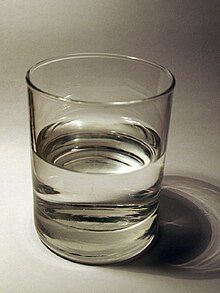Drinking glass
The drinking glass is a drinking vessel made of glass into which drinks are poured and from which people drink directly. It exists in very different forms and is often used to consume beverages in everyday life.
production
With a few exceptions, such as high-quality mouth-blown wine and champagne glasses, drinking glasses are made from industrially manufactured pressed glass , i.e. pressed hollow glass .
Use of words as counting word
In German, glass is a counting word in the sense of drinking glass , and it means “two glasses of milk” instead of “two glasses of milk” when it comes to the amount, not the pieces.
Executions
Depending on the drink and the occasion, different glass shapes are used:
Beer glass
The beer glass is often, but not always, printed with the trademark of a particular type of beer. This is how the beer glass differs from other types of glass. It is often cylindrical, made of comparatively thick glass and, in contrast to almost all other glasses, often has a handle, preferably in Bavaria. On the one hand, the handle increases the number of glasses that the operator can distribute to the guests at the same time, but on the other hand it also makes drinking easier, as beer glasses hold relatively large amounts of substance (a Bavarian measure corresponds to about one liter), so the glass is very large and without Handle with one hand would be impossible to grasp. The wheat beer glass is a special style of beer glass. It's slightly spherical at the top and tapers towards the bottom before ending in a wider foot. The glass can be recognized by its strong sidewall. Other beer glasses are cylindrical: the so-called "Stangen" (a narrow one for Kölsch , a wider one for Düsseldorfer Alt ) or the so-called " Tulips ", glasses with a stem similar to a wine glass.
Wine glass
The shape of the wine glass resembles a truncated ball in red wine glasses (or a truncated ellipsoid in white wine glasses ). The closed side of the three-quarter ball points downwards and sits on a thin glass stem, which in turn attaches to the base of the glass. There are serious quality differences with this type of glass . While in some cases cheap and simple glasses made of relatively poor glass can be found, the quality of which is only sufficient for very low demands or infrequent use, there are also expensive glasses made of crystal glass , which can be decorated by grinding or attaching. Crystal glass has a more open-pored glass surface, which supports the evaporation of the molecules of the wine and the absorption of its scent ("nose" of the wine ). The glasses are different depending on the wine, for example large-bellied glasses are used for red wine so that the wine can "breathe", i. H. Can release aromas into the open air. Valuable wines are filled from carafes into wine glasses.
Champagne glass
A popular shape is the champagne flute, which is similar to the wine glass, but has a smaller diameter and therefore appears slimmer and taller overall. Near the lowest point on the inside, it often has a mousse point , which is supposed to promote the sparkling out of the carbon dioxide . There are also other glass shapes such as champagne bowls .
Water glass
The water glass is usually used to drink water and is therefore consistently found in restaurants. It is often, but not always, imprinted with the trademark of a particular type of water. This is how the water glass differs from other types of glass. It is often cylindrical, consists of comparatively thin to medium-thick glass and has a capacity of 0.2 l (200 ml) to 0.3 l. Festive water glasses often also have the shape of wine glasses, with the shape of the cut ellipsoid lying between a champagne flute and a white wine glass. If there are several glasses, the water glass is always on the far right on the laid table .
Cocktail glass
The cocktail glass is typically used for cocktails . Depending on the drink, a number of different shapes and types are distinguished, for example the martini glass . The capacity of cocktail glasses is usually between 100 and 200 ml.
Shot glass
A standardized schnapps glass (also called Pinneken , Pinnchen or, especially in Austria, Stamperl ) holds 2 cl (20 ml) or 4 cl for "doubles". In Austria a “triple” with 6 cl is also available. It is cylindrical with a solid base and thin walls. As a rule, it is filled with high-proof alcoholic beverages and, in certain situations, emptied in one go (colloquial: "on Ex"). In other countries, other filling quantities are common, and a “double” does not necessarily contain twice the amount of a simple shot glass. For example, single and double shot glasses are 1.5 fl oz and 2.5 fl oz (45 and 75 ml) in Canada , 1.5 fl oz and 3 fl oz (45 and 90 ml) in the USA , 35 and in Ireland 71 ml, 25 and 50 ml in the UK and 30 and 60 ml in Australia.
Snap pipes represent a special shape . These can be made of glass or ceramic . The contents are drunk through the drinking neck like with a drinking straw by being sucked in. Depending on the type of spirit, the vessel can e.g. B. can also be referred to as a cognac pipe or whiskey pipe .
More drinking glasses
Image examples
Antiquity or the Middle Ages
Glass chalice Thutmose 'III. (around 1450 BC), oldest glass vessel in the world that can be definitely dated, State Museum of Egyptian Art , Munich
Ornate trunk cup (around 6th century)
Modern
White wine glass in Germany
Web links
Individual evidence
- ↑ My work: Schnapspfeifen. glaskunst-reinhard.de, accessed on March 26, 2016 .








